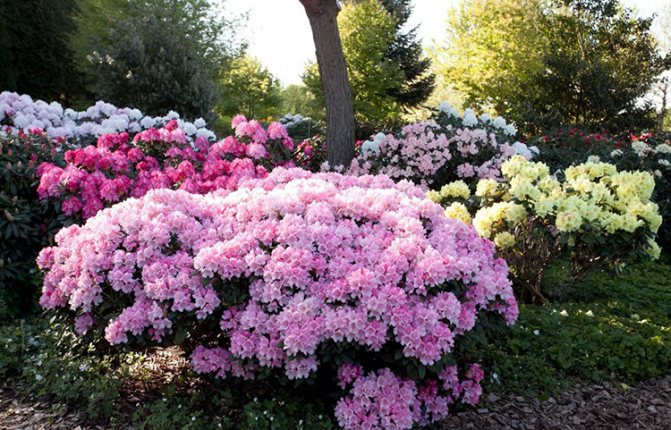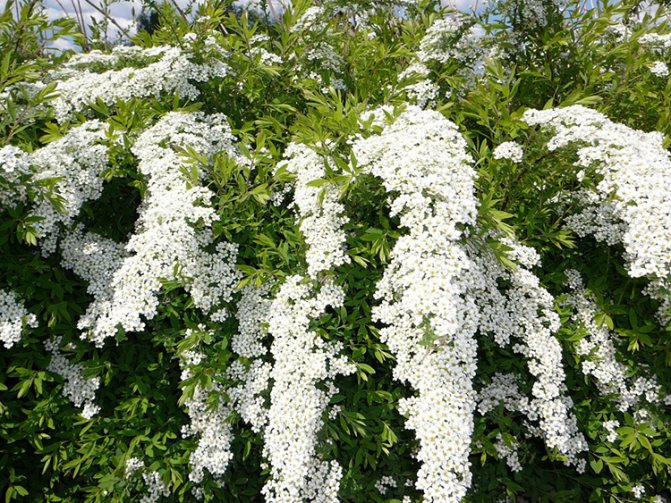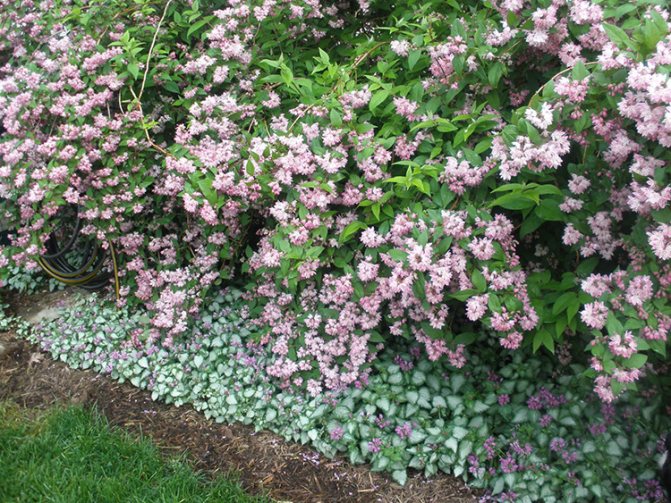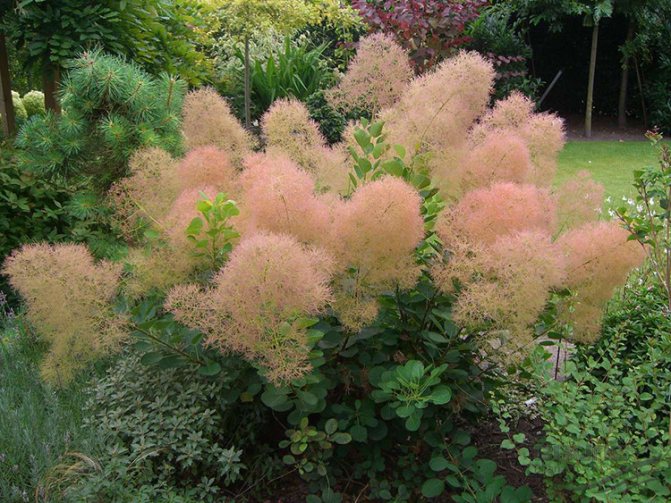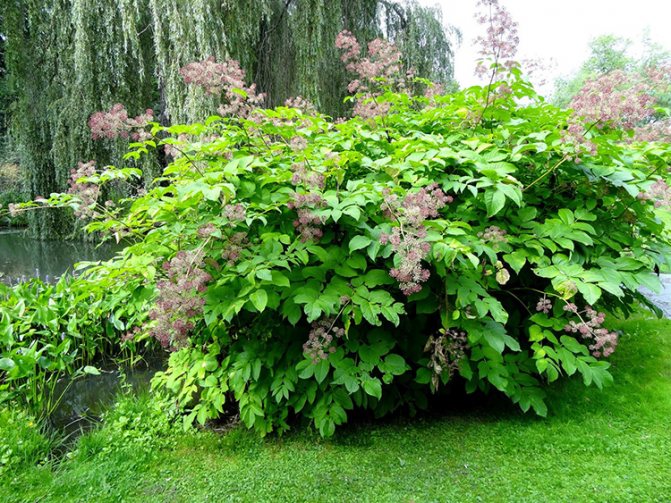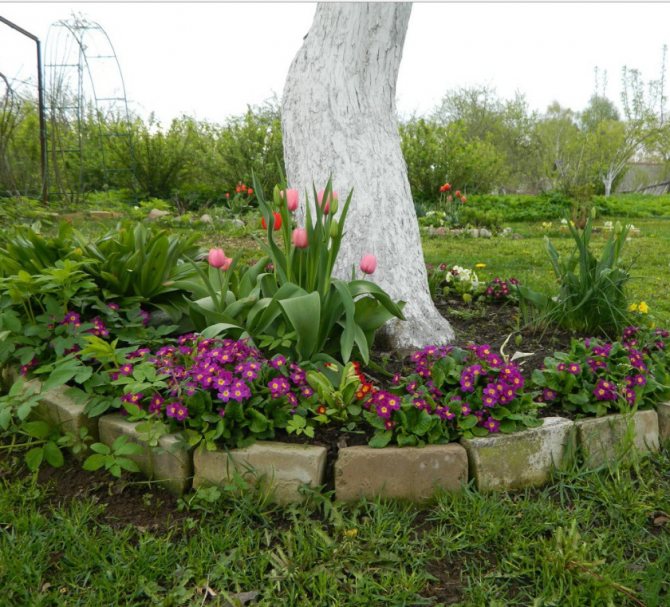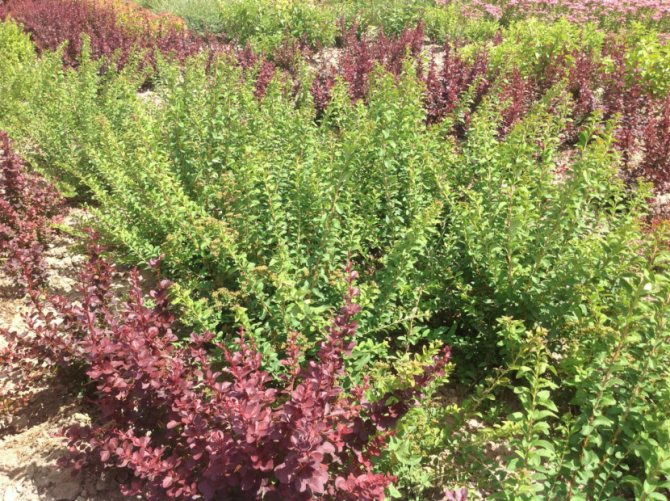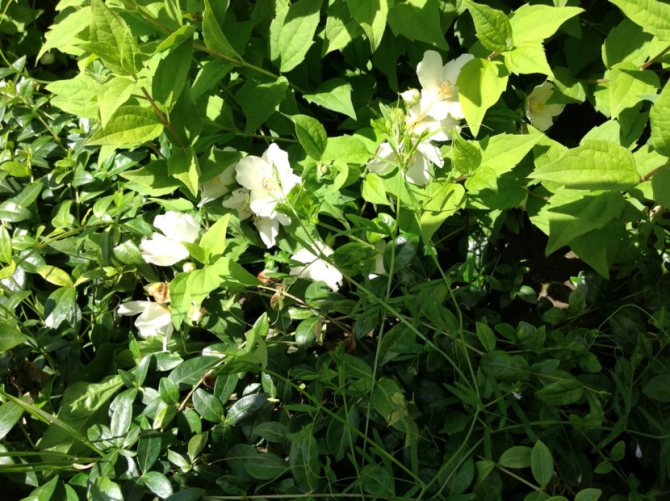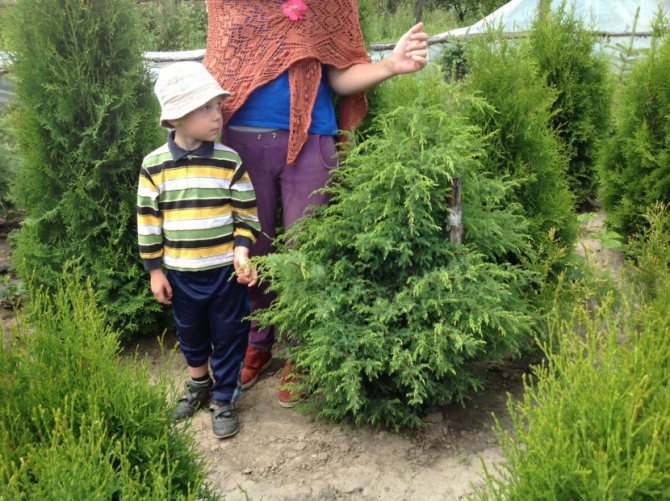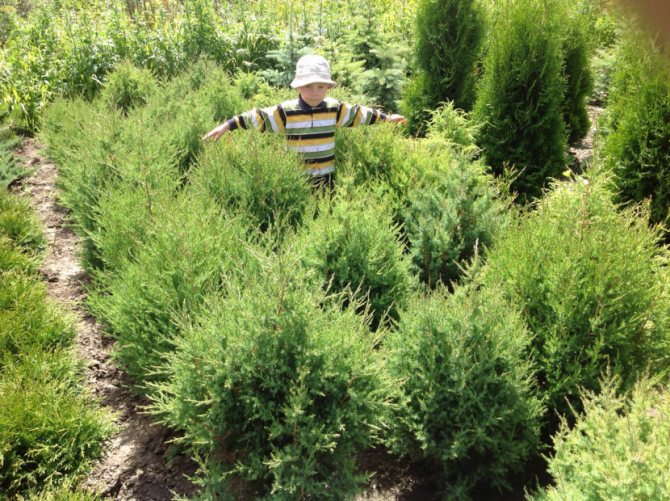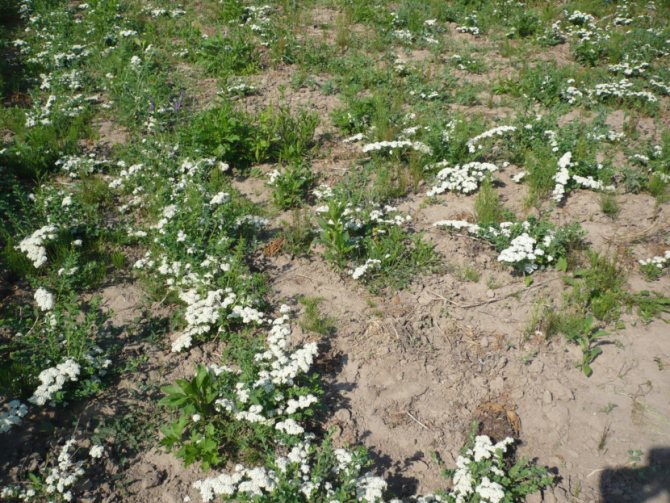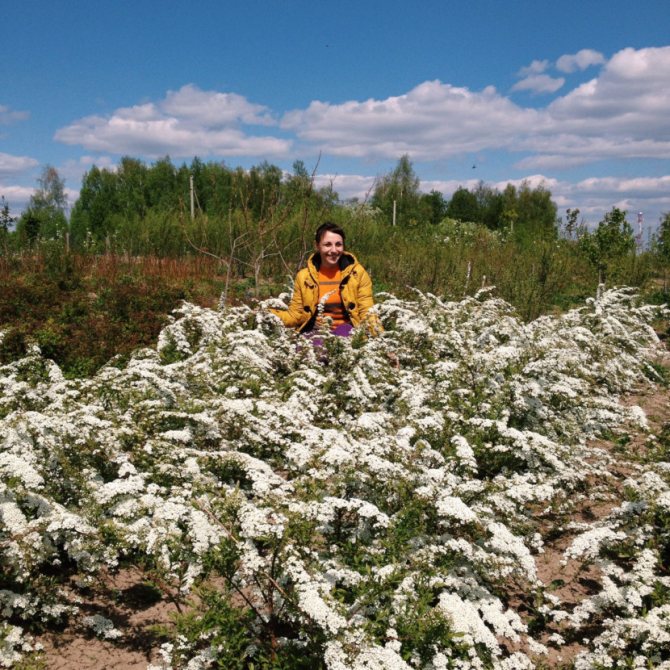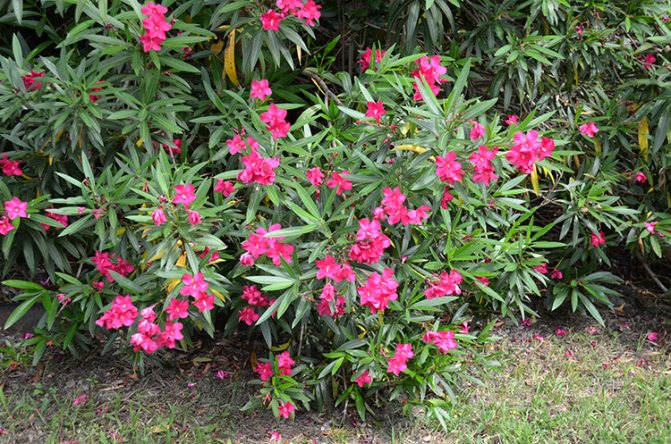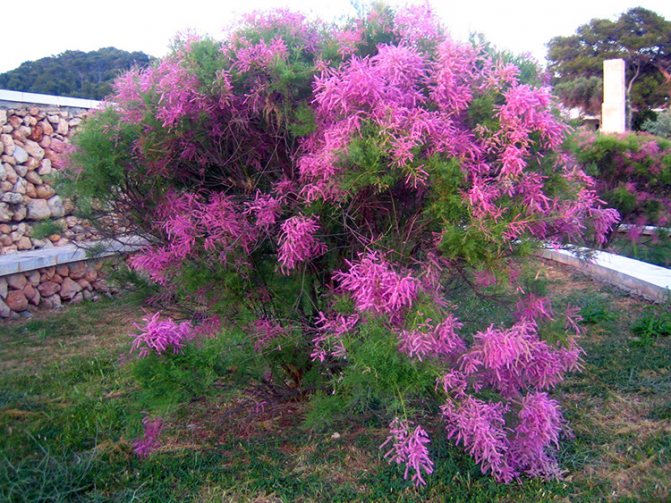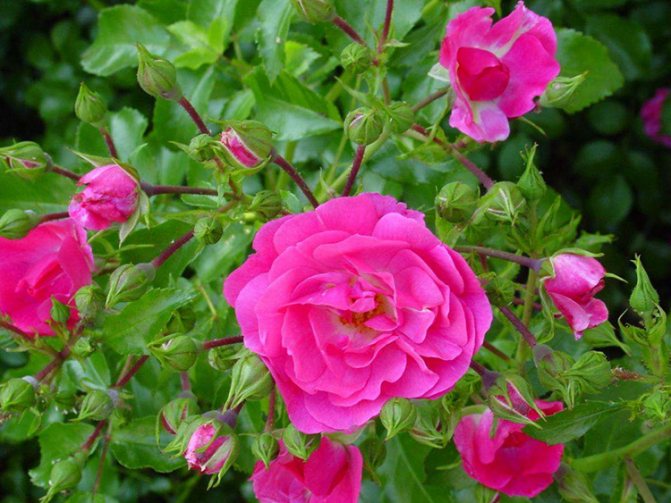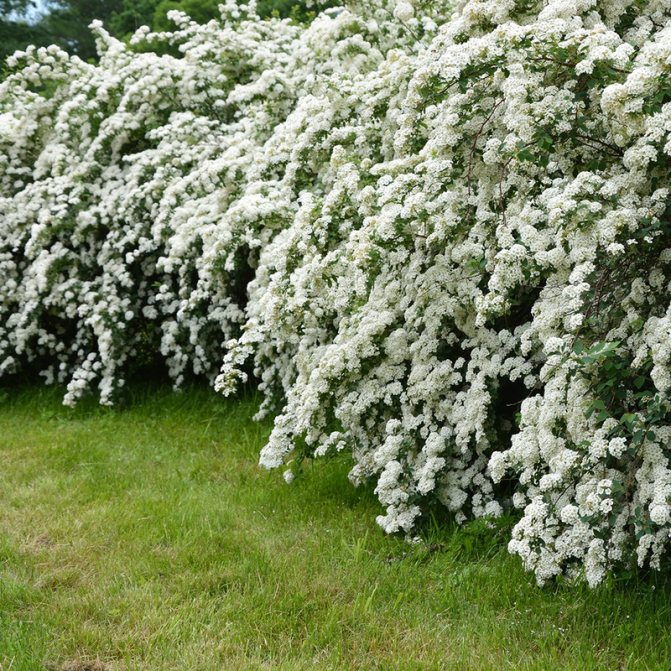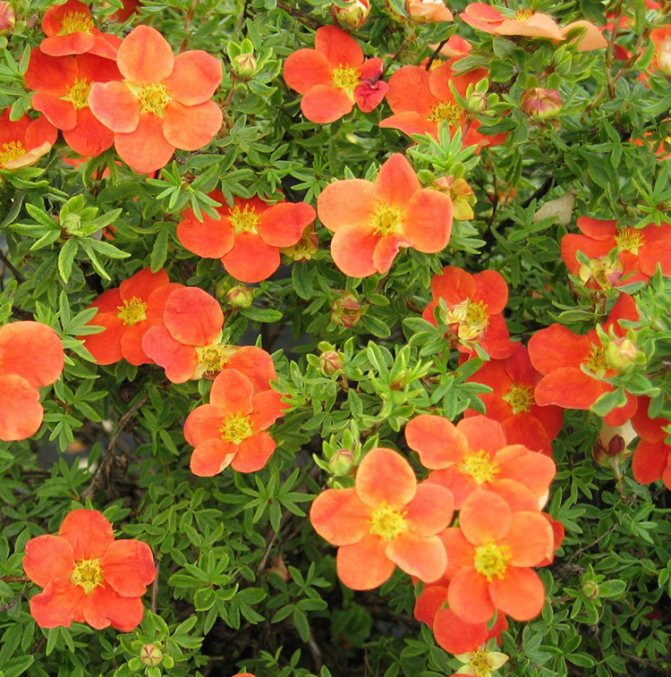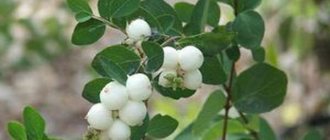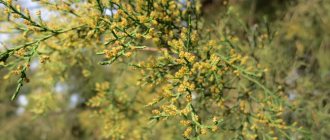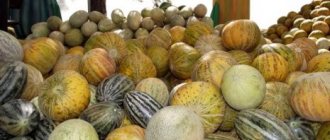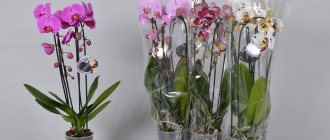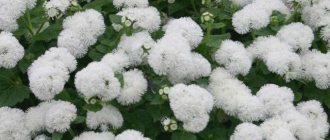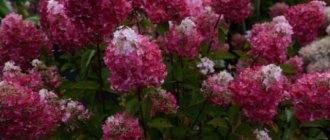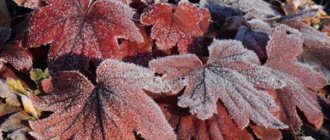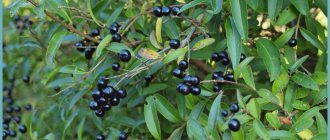I offer you a selection of 12 of the most beautiful winter-hardy shrubs with minimal maintenance (not to be confused with "no maintenance") that will delight you throughout the season. Some of them are already growing in my garden, while others I plan to plant in the very near future.
- Selection criteria for ornamental shrubs
- Beautifully flowering shrubs Hydrangea
- Bloodroot
- Lilac
- Spirea
- Chubushnik
- Barberry
- Horizontal cotoneaster
I really like it when the plants in the garden take turns taking turns passing the baton to each other. This gives a more complete and rich picture of the garden, because decorativeness persists from April to November.
Selection criteria for ornamental shrubs
I propose to conditionally divide the shrubs into 3 groups:
- with variegated (variegated) foliage and decorative bark
- with beautiful flowering
- with bright fruits
Please note that some shrubs can be simultaneously included in several groups at once.
Some plants have nondescript flowers, but at the same time stand out with colorful fruits. And about others, we can say that they look impressive from spring to autumn: their decorative effect does not end after flowering.
So I suggest you list of 12 shrubs, and you yourself decide which corner of the garden to plant in order to enjoy their splendor. Most of the presented plants have a winter hardiness zone (USDA) 3 (up to -40 ºС) and 4 (up to -35 ºС), do not require additional shelter in winter. In the material, the winter hardiness zone is indicated next to the variety name in brackets.
Species characteristics
- Frost resistance: very frost-resistant, moderately frost-resistant and frost-resistant ornamental shrubs.
- Illumination: light-loving, shade-tolerant.
- By fertility: flowering, decorative deciduous, fruiting.
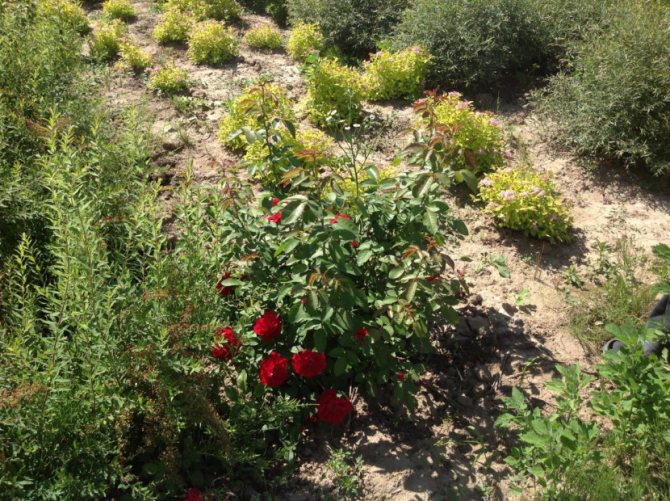
Beautifully flowering shrubs
The main advantage and attractiveness of this group of shrubs is their beautiful flowering. Single or collected in dense inflorescences, simple in shape or double, of a delicate creamy shade or bright purple color, with a light or rich alluring aroma, flowers will not disregard either butterflies or you and me. Consider as flowering shrubs hydrangea, cinquefoil, lilac, spirea and chubushnik.
Hydrangea


Hydrangea paniculata
I will not focus on large-leaved varieties of hydrangea, we will leave them for amateurs who have a lot of time: in the fall, tear off all the foliage, bend it to the ground, cover it and put a load on top so that the whole structure does not shoot like a slingshot. Yes, the spectacle is not particularly attractive until the snow has fallen, but what about the year-round decorativeness of the garden? No, I'm not ready for that. I prefer treelike and paniculate varieties of hydrangeas, the latter I prefer. Although they do not have a wide color palette of blue and lilac shades, there is a very small range of pink, but pink is still present, and what kind.
I think you already know how the tree-like hydrangea visually differs from the paniculate hydrangea: the latter has a more elongated inflorescence, similar to a cone or pyramid, and the tree-like one has a rather flattened cloud.
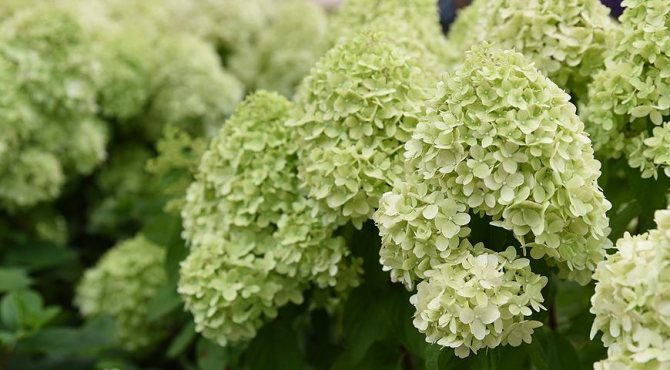

Hydrangea paniculata Magical Mont Blanc
I really like the Limelight panicle hydrangea (USDA 4), a bush up to 2.5 m high, up to 1.5 m wide with rich lime-colored inflorescences. Or look at the “bashful” varieties that take on a rosy blush over time and some fade completely into crimson: Diamand Rouge (USDA 4), Magical Fire (USDA 4), Sundae Fraise (USDA 4), and Vanille Fraise (USDA 4) - they all change color gradually from creamy white in summer to varying degrees of saturation of pink-red in autumn.
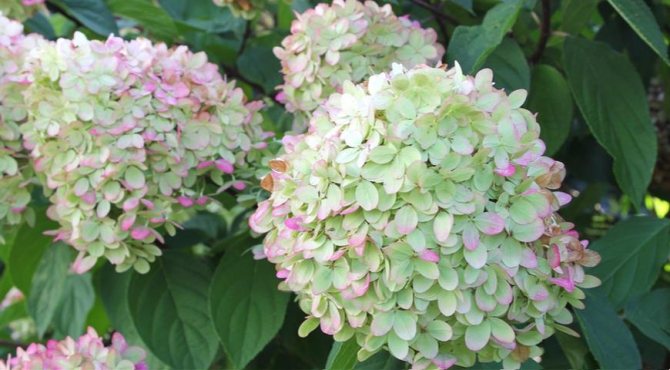

Hydrangea paniculata Limelight
If the choice is made in favor moth varieties of panicle hydrangea, then in late autumn you can not cut the inflorescences and they will become a winter garden decoration. On other hydrangeas, it is advisable to remove the inflorescences so that the plants can easily endure winter snowfalls and do not break under the weight of the snow. Just admire the delicate lace of Kyushu (USDA 4), Early Heary (USDA 4) or Big Ben (USDA 4) hydrangea. Yes, these are not densely packed caps of inflorescences, this is already silk among fabrics, more graceful inflorescences, do not bend either from rain or wind. The charm of moth varieties is their airiness and lightness, they will perfectly fit into gardens of any style.
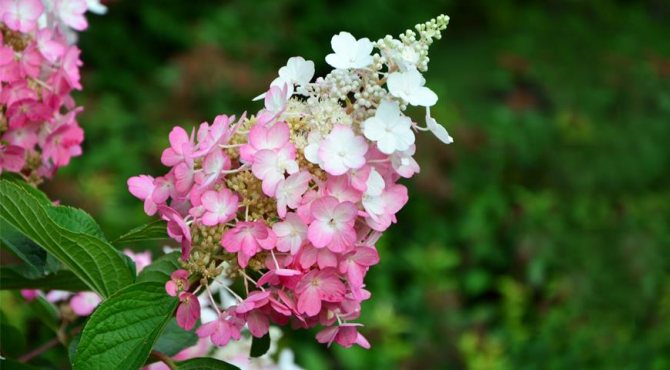

Hydrangea paniculata Candlelight
Hydrangea is a shrub that loves partial shade. Of course, it can and will grow in the sun, but its inflorescences will burn out and dry faster in dry weather. Consider this small but very important feature when choosing a place for future plantings, also remember that hydrangeas love acidic soil. Buy high moor sour peat in a store or in a coniferous forest, remove the top 20 cm of soil under spruces and pines. Hydrangea paniculate and treelike must be cut in spring or autumn so that the bush does not disintegrate and gives more side shoots, on which lush inflorescences will appear.
In landscape design, hydrangea is planted in mixborders, in group and in single plantings. Good for hedges. Plant low-growing varieties along the path or at home, and tall ones along the fence, and enjoy the unique flowering all season. Standard forms also look great.
Cinquefoil, or Kuril tea
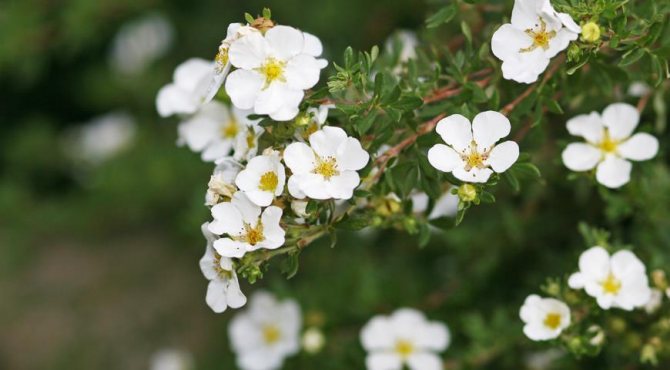

Shrub cinquefoil
Against the background of green color in the garden, the gray-green foliage of Potentilla will in itself become a decoration of the garden, and when the flowers bloom, the bush becomes unusually beautiful. Potentilla blooms for a long time, from June to October. Perhaps no shrub can boast of such a variety of color palettes: white, yellow, pink, red and even orange flowers, there is certainly plenty to choose from. The crown is dense, spherical, with a height of 40 cm to 1 m, depending on the variety.


Shrub cinquefoil
For lovers of yellow varieties, take a look at the Goldstar (USDA 3) and Goldfinger (USDA 3) varieties of Potentilla; pink varieties are suitable for New Dawn (USDA 3), Pink Queen (USDA 3), Bellissima (USDA 3); orange - Hopley's Orange (USDA 3), Mango Tango (USDA 3); Reds - Marian Red Robin (USDA 3); whites - Snowflake (USDA 3), Abbotswood (USDA 4).
The shrub is good as a tapeworm or in group planting with other shrubs and conifers. If necessary, you can correct the shape of the bush with a haircut.
Lilac
Lilac can rightfully bear the title of "queen": it is always beautiful, as soon as it is caressed by the first rays of the sun, dark green leaves bloom, flower buds appear, and voila, we see a lilac strewn with luxurious inflorescences with double or simple flowers different shades of purple, lilac, white and even pink. Aren't the lush inflorescences crowning the bush look like a royal tiara?


Lilacs: Katherine Havemeyer, Esther Staley, Cavour
Probably the most remarkable and unusual lilac is the Aucubaefolia cultivar (USDA 4). Large spreading shrub up to 3-4 m in height with variegated yellow-green foliage, with soft lilac inflorescences. The foliage of the bush is not at all typical for lilac: the yellow lines and spots on the heart-shaped leaves resemble the work of an artist who, with careless strokes, applied paint to the canvas.


Lilac Aucubaefolia
Flowers can also become a distinctive feature of the variety.
Sensation lilac (USDA 4) is a large shrub with a spreading crown up to 3 m high and delicate inflorescences of small flowers of a deep dark purple color with a snow-white border. This variety should be in every garden.
If you want a lilac with a rich dark purple hue, pay attention to the lilac variety Ludwig Spath (USDA 4) - a fairly tall shrub (up to 4 m in height) with a wide crown.
If you prefer white lilacs, plant Angel White (USDA 4) in your garden - a shrub up to 2.5 m high with large, snow-white inflorescences with simple flowers. But with the modern variety in nurseries, you can choose other available options: Mme Lemoine (USDA 4), Monique Lemoine (USDA 4), Krasavitsa Moskvy (USDA 4), Memory of Kolesnikov (USDA 4).
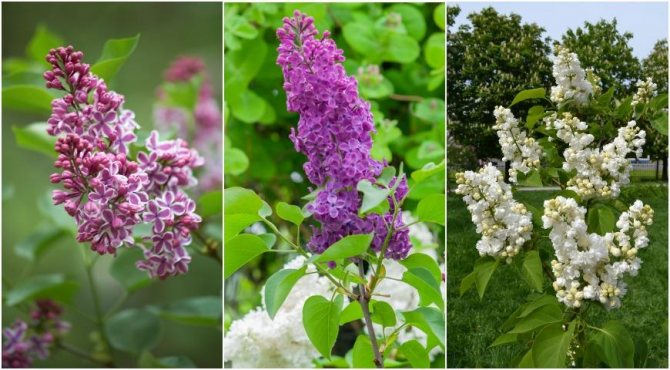

Lilacs: Sensation, Ludwig Spath, Memory of Kolesnikov
Lilac is suitable for any task in the garden, the main thing is to put it correctly: tapeworm, hedge, group planting, composition with conifers or perennials. And depending on the variety: early, medium or late - flowering can be extended from May to July.
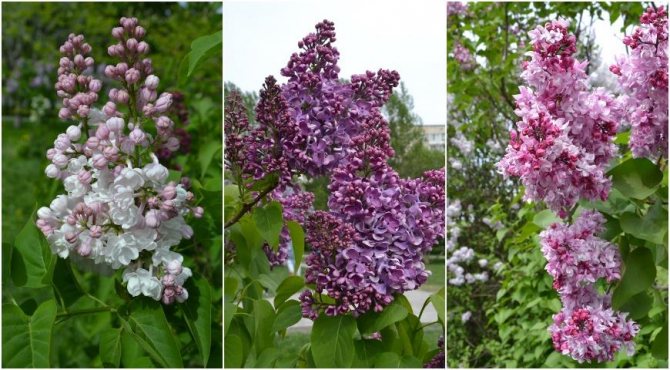

Lilacs: Beauty of Moscow, Kremlin chimes, Kolesnikov Olympics
Read more interesting information about lilac varieties in the material on our website.
Spirea
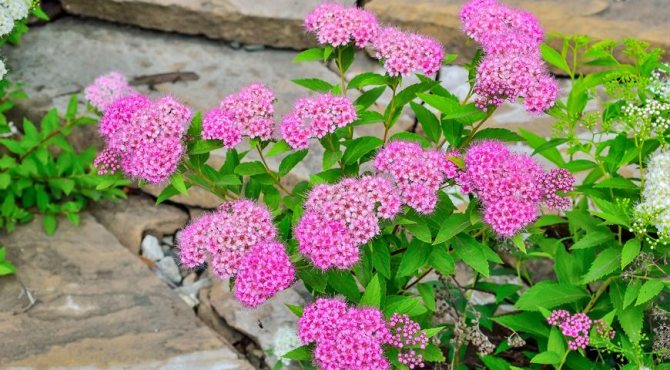

Japanese spirea
The most versatile, most decorative shrub of all time is the spirea. Whoever says anything, she is number one for me. It blooms from May until the end of summer, depending on the variety. There are plants with umbellate inflorescences, and there are in the form of candles. It blooms in white or pink, and the Japanese Spirea variety Genpei (USDA 4) blooms in three colors at the same time: white, pink, and red.
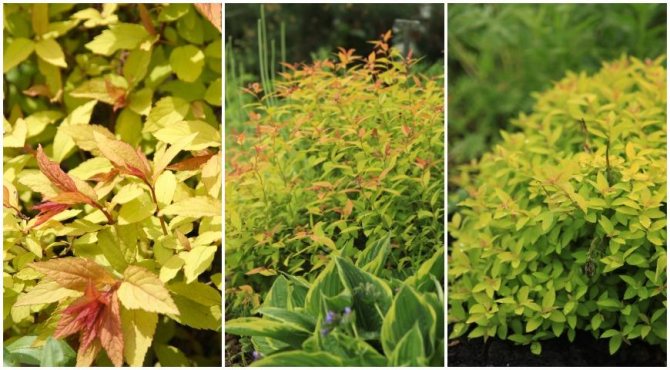

Spireas: Japanese, Gold Flame, Gold Princess
If you want a ground cover shrub - no problem, there are suitable dwarf spirea varieties: Golden Carpet (USDA 4) with light green foliage only 20 cm high or Japanese Dwarf (USDA 4) with bright green foliage up to 30 cm high.Both shrubs are slow-growing, flattened ball with pink inflorescences.
For the curb, take a look at the spireas: Golden Princess (USDA 4) - a shrub up to 60 cm high with the most golden / yellow foliage of all spiraeas, Little Princess (USDA 4) - up to 80 cm high or Goldflame (USDA 4) - up to 80 cm high - all these shrubs are spherical and can be cut well.
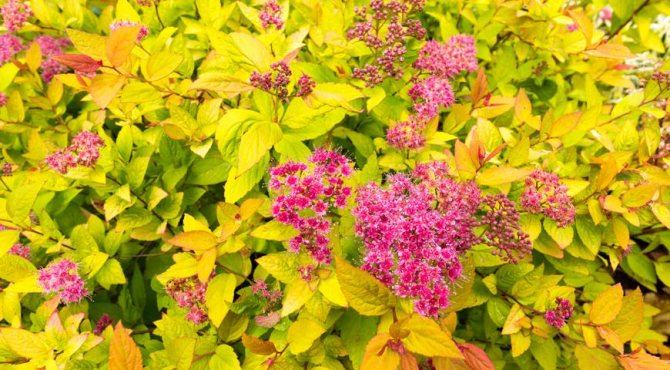

Spirea Golden Princess
And if you like the fountain shape, then this is the Wangutta spiraea (Spiraea × vanhouttei) (USDA 4) up to 2 m high or the gray spirea Grefsheim (USDA 4) up to 1.5 m high.They bloom in early spring with white flowers along the entire length of the flowing branches.
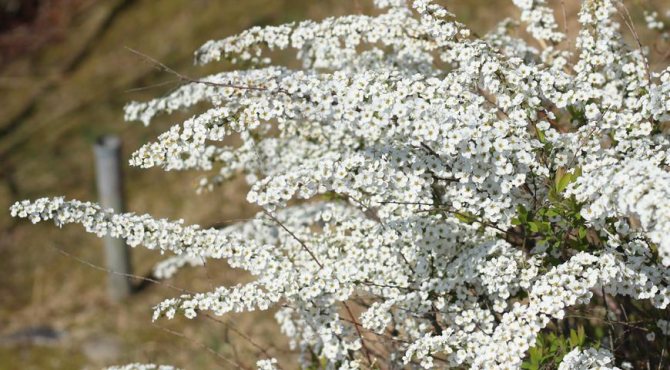

Spirea Grefsheim
Shrubs with candle inflorescences - Spiraea billardii (USDA 4) up to 2.5 m high or Spiraea douglasii (USDA 4) up to 1.5 m high with long straight branches - ideal for hedges.
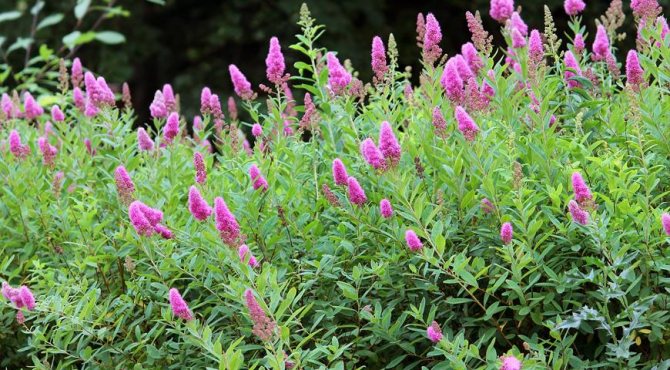

Spirea Douglas
Using varietal varieties of spirits, you can collect an excellent woody composition: according to the color of leaves from gray-green to bright yellow with red tips; in color and shape of inflorescences, in bush shape and in height.
Spirea responds well to formative pruning. After flowering, remove the wilted inflorescences, although if the candle inflorescences are not cut off, they will decorate the garden in the autumn-winter period against the background of the first snow.
Chubushnik, or garden jasmine
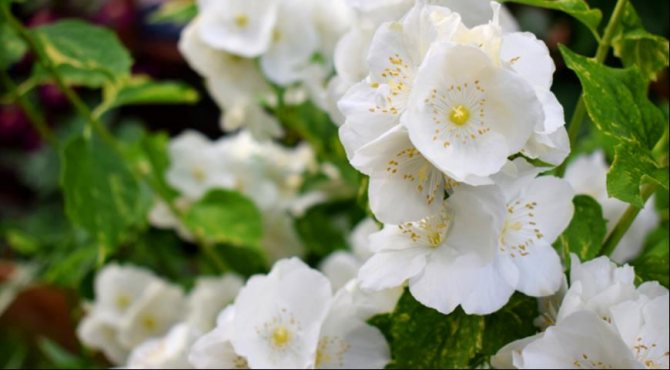

Chubushnik
Chubushnik, or garden jasmine, has been soloing in the garden and delights with its unforgettable pleasant and sweet aroma since June. During flowering, the bush is completely covered with white simple and double flowers.
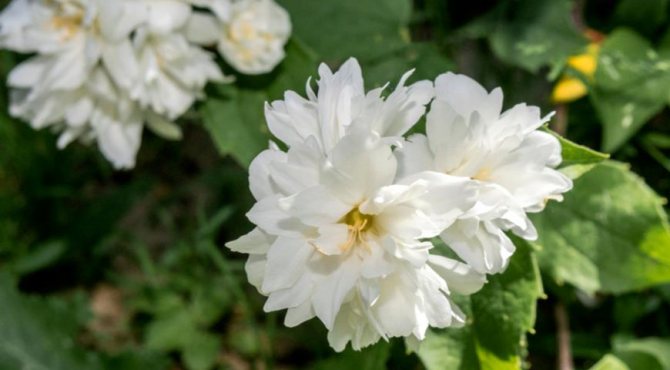

Chubushnik
The most persistent and time-tested is the Philadelphus coronarius (USDA 3). A shrub with numerous straight stems drooping during flowering, up to 3 m high. Terry varieties look very attractive, for example, Frosty Morn (USDA 4) - a bush up to 1.5 m high with white double inflorescences and yellow stamens in the center of each flower. No less beautiful is the Minnesota Snowflake (USDA 4) cultivar up to 2 m high with double snow-white flowers consisting of many pointed petals, which gives the plant a special charm.


Chubushnik Aureus
There are also varieties with bright light green foliage among the mocklings, for example, the Aureus variety, and the Variegatus variety with variegated foliage, however, they have a winter hardiness zone of 5 (up to -29 ºС), which means that in the Middle Lane it will freeze slightly without shelter.
A mock-orange is formed after flowering, since it blooms on last year's shoots, and if you do this in early spring or late autumn, then you can not wait for flowering.It is preferable to plant chubushnik in the sun, but it can grow in partial shade with more modest flowering.
In the garden, the bush is suitable for single and group plantings. Looks great as a green hedge.
Snow berry care
The snowberry is an unpretentious plant, it adapts to growth on poor, dry and moist soils. It is able to grow in full sun or partial shade. It has strong underground rhizomes, so planting it on slopes helps with soil erosion.
Landing
Planting the "snow berry" spend in spring, or in early autumn. For young animals, you should choose areas that are slightly shaded.
An adult plant can survive on arid soil, the root system of which is able to receive moisture from the ground on its own. Young shrubs will need watering to form roots.
Step-by-step landing instructions
- For the initial planting, you will need to create a quality substrate; a mixture of sand, humus and turf can be used as a suitable soil. Pour drainage (crushed stone or expanded clay 10 cm) at the bottom of the planting hole.
- Planting root set as vertically as possibleby slightly straightening its lateral branches. The neck of the bush should not be buried; it should be at the level of the soil.
- Sprinkle with prepared soil, slightly shaking the plant, helping the soil to occupy all the cavities between the rhizomes.
- After planting, compact the soil and shed water. Watering should be carried out within 3 weeks, in the absence of precipitation.
- It is better to tie a young bush to a support until it gets stronger.
- Taking into account the growth activity, the distance between plantings must be between 0.7 meters.
Spring Summer Care
In the spring, when the soil thaws, you need to dig it up around the bush. Cut out all dead wood with pruning shears. Fertilizing a snow berry is optional, but desirable. Compost or humus is used as a top dressing.
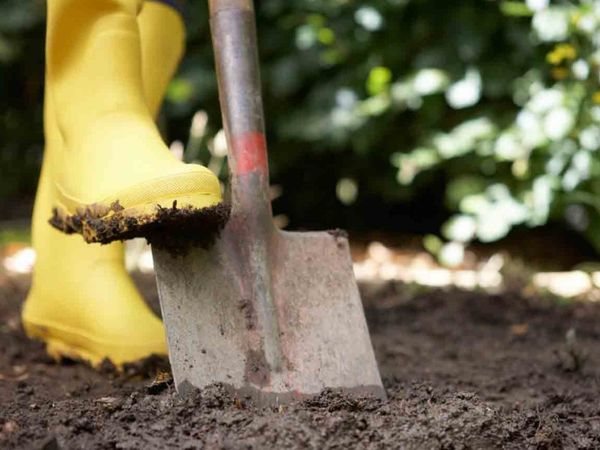

Digging up a flower bed in the spring is good for the plant.
In the summer, when there is an abundant overgrowth of weeds, it is necessary to weed the snowberry.
Pruning
If the "snow berry" shrub plays the role of a hedge, its crown is pruned in order to form a decorative and well-groomed form. Pruning time April-May, before the season of active sap flow.
Watering
For adult bushes no watering needed, and young animals can be pampered with water in a drought. Tap water can be used, but standing water or rainwater is best. Charcoal is used to soften the water.
Autumn-winter care
The snowberry does not require any additional care in the fall. Watering and feeding at this time should be stopped. The shrub is frost-resistant and does not require additional shelter (with the exception of the rarer pink varieties).
Diseases and pests
Snowberry is a healthy plant. It has strong immunity and is resistant to disease.


Powdery mildew is a dangerous fungus that can lead to plant death
A great danger to him is represented by: gray rot, powdery mildew... They belong to the category of fungal diseases and appear due to high soil moisture. They can harm the plant, up to its death.
Treatment and prevention
For the purpose of prevention and treatment, you can use Bordeaux liquid, calcined salt, ordinary laundry soap. Spraying is carried out in early spring or as needed.
To prevent the snow berry from getting sick, do not plant shrubs in areas that are too humid and clayey. Check the plant regularly for health.
Shrubs with colorful foliage and bark
In the middle of summer, the eye gets used to the rich green color and wants something special. Shrubs with colorful leaves and bold bark will dilute strict greenery and bring bright colors to the picture of your garden. Take a closer look at the most unpretentious and interesting types: barberry, elder, derain and vesicle.
Barberry
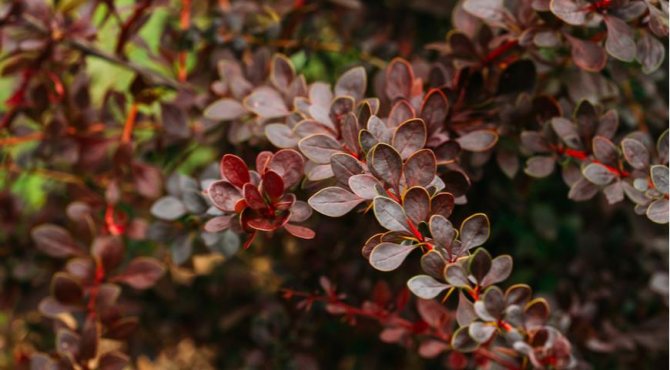

Barberry Thunberg
This plant will save you in any situation: if you want to add yellow colors to the garden, the Thunberg barberries Golden Rocket (USDA 4), Golden Pillar (USDA 4) are perfect; want dark colors - Dart's Red Lady (USDA 3), Atropurpurea Nana (USDA 4), Concorde (USDA 4), or bright red Lutin Rouge (USDA 4); Natasza (USDA 4) with pink-green-white foliage or Harlequin (USDA 4) with burgundy leaves with white and pink spots.


Barberry Thunberg Harlequin
By the fall, many varieties change the color of the leaves to bright orange or red. Try to plant a hedge of barberry, and in November you will see a transparent (without foliage) dense bush with a red speck - these are berries that are simply strewn with shrubs, an amazing sight!
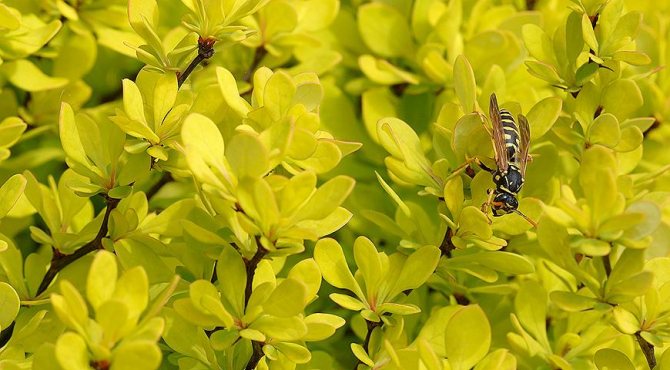

Barberry Thunberg
Depending on the variety, barberry can be of different heights from 50 cm to 3 m, it can be with a spreading crown and vice versa, grow upward, like a column. Barberries also differ in winter hardiness (3-5 zones). Also, do not forget that in the shade, the decorative properties of the plant are not as pronounced as in the sun. Therefore, before buying, decide on the place of future planting, what function the plant will perform and choose a variety that meets all your conditions.
Elder


Elderberry Black Black Lace (USDA 5)
Of all the varieties, the most attractive is the black elderberry of the Black Beauty (USDA 4) variety with dark purple leaves, almost black, in autumn - red. Flowers of a pale pink shade are collected in large inflorescences, up to 15 cm in diameter. Tell me, how can you pass by such splendor? Well, in the fall, the bush is strewn with dark purple berries.
Elderberry is a fast-growing shrub up to 4 m high with a spreading crown. Some gardeners prefer to make standard forms and grow elderberries in one trunk, it will take more than one year for the bush to reach the desired size, while the root shoots must be carefully cut every season. But since the desire is so great, you can pay due attention to this shrub. The bush responds well to a haircut, although it is better to carry it out in early spring before the start of sap flow, so you can maintain the necessary density of the plant and restrain a fairly strong growth (in a good year, more than 50 cm per year).
The garden looks great both in single and in group planting with other trees, shrubs and perennials.
Derain


Derain white Elegantissima
Derain, although it blooms with pretty white flowers, however, is not famous for this. Foliage is the main horse of most varieties: green with a white border - Elegantissima (USDA 4), or with a yellow border - Gouchaultii (USDA 4).


Derain white L. variegata
There is not a single park in Moscow where you would not meet a dogwood, which, as it were, greets you, stretching out its branches that have grown after a shearing under the breath of the wind. By the middle of summer, unpretentious white fruits appear. If you think that this is all that this shrub is capable of, do not rush, wait until all its noble foliage has fallen off and a dogwood appears in front of you in a new costume: fiery red or bright yellow bark. Plant a blood-red Midwinter Fire (USDA 4) turf, which in summer has bronze-tinted foliage without a border, but in autumn it will not go unnoticed: the bright yellow bark with a transition to blood red at the ends burns in the sun. Give him a place in the background so that he can solo in the garden in late autumn and winter, and let perennials, cereals or other low-growing plants perform against the background of his green foliage.
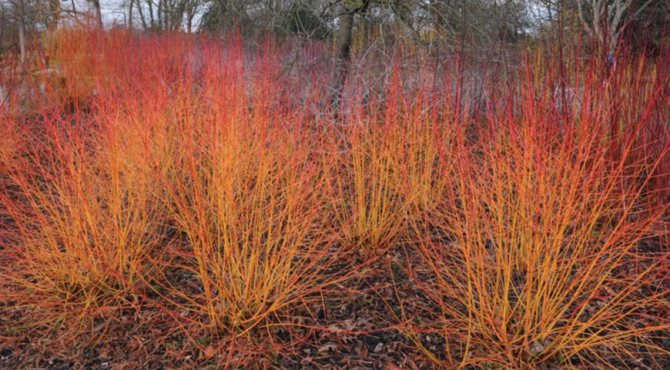

Derain Blood Red Midwinter Fire
Derain is a fast-growing shrub up to 3 m in height with a wide spreading crown. Whichever variety you choose, give it enough space in your area, do not plant too densely with other plants, unless it is a hedge. It responds perfectly to a haircut several times per season (spring - autumn), thanks to which it is possible to maintain the bush in the desired shape and restrain growth.
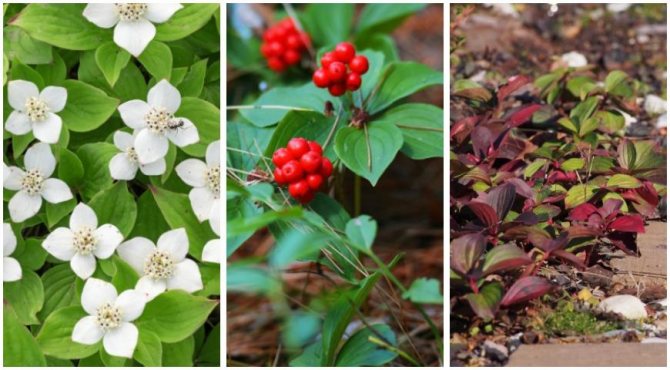

Derain (Cornus canadensis)
The exception among the trees is the ground cover dwarf Canadian tree (Cornus canadensis) (USDA 3), shade-tolerant and unpretentious, up to 20 cm high, with green foliage, but its main difference is bright red fruits, which, along with the autumn color of the foliage, will add their own smear onto the canvas of your garden.
Bubble
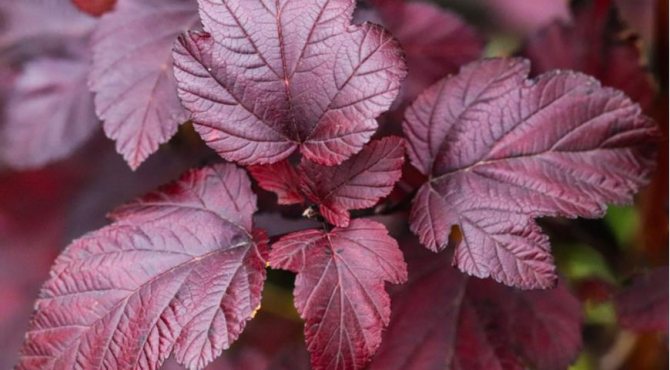

Bubble-leaf Vine-leaved
The gamut of color variety of bladder leaves allows you to combine several varieties in one area. Just do not overdo it: you quickly get tired of the abundance of contrast! Better to play on coloristic nuances. This avoids abrupt transitions and softens contrast in compositions.
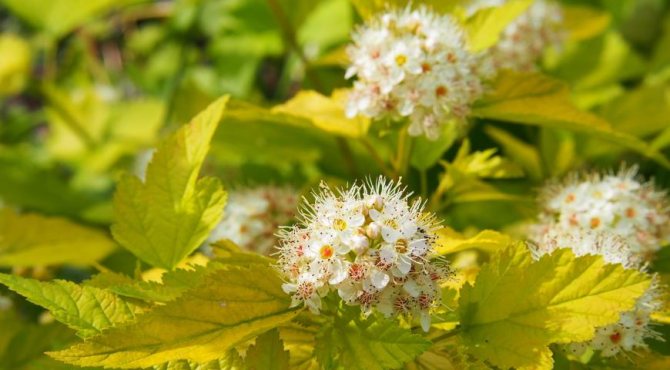

Bubble-leaf Vine-leaved
Take a closer look at varieties with variegated foliage: Golden Anny (USDA 4) with pale green leaves with an uneven creamy yellow border around the edge and Anny's Gold (USDA 4) vesicle with yellow-green variegated foliage with small spots. Cultivars Luteus (USDA 3) and Darts Gold (USDA 4) with intense yellow leaves and white flowers, collected in hemispherical inflorescences. Amber Jubilee (USDA 4) leaves change color from yellow through red-orange to lime, turning purple-violet in autumn. Diabolo bubble (USDA 3) with chocolate-purple leaves and pink-white flowers, and Tiny Wine (USDA 4) with bright burgundy leaves and delicate pink flowers.
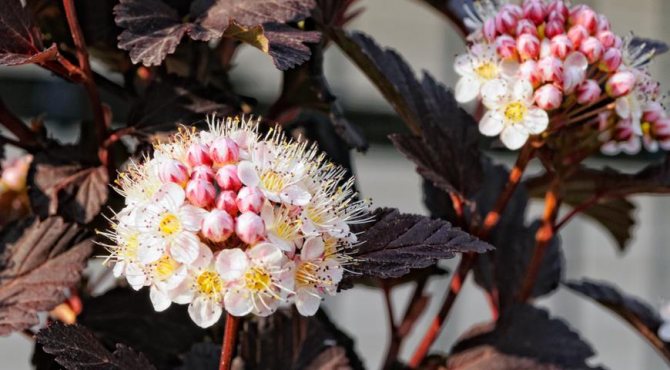

Bubble-leaf Vine-leaved
The bubblegum feels great both in the sun and in partial shade, however, the brightness of the leaves decreases when planted in a shaded area. Bubble fruits look like small dark purple bubbles that do not fall until spring and serve as a natural decoration for the garden.
The bubble plant easily responds to pruning, you can form a ball or give the shrub clear geometric lines. The shrub responds well to anti-aging pruning on a tree stump. Looks impressive in a single planting, as well as in composition with other shrubs and trees, suitable for hedges.
Reproduction
The snowberry has several breeding options, they are all used to increase the number of plants.
Root shoots
An adult "snow berry" bush forms a root growth, thus, it moves on its own on the surface of the earth. Digging up such growth, you can plant a large number of new plants in a few years.
The landing period is spring, autumn. The method is often used in practice.
Division
The division method is more complex, it implies digging out the mother bush and its dissection into 2 or 3 independent plants. It is rarely used, because in order to dig up an adult bush, great physical efforts will be required.
Layers
This method consists in pressing the lower shoots of the shrub to the ground in the spring, sprinkling it with soil and pinning it down with wire. Thus, the branches will take root and small bushes with a good root system will form in the fall. Layers in the fall are cut off from the main bush and transplanted to a new place.
Cuttings
Cutting method used much less often... It consists in the fact that cuttings with 3-5 buds are harvested, each 15-20 cm long. Cuttings are cut after the plant has finished flowering.
For cuttings, large, mature shoots are suitable, which should be woody. They are placed in water (or in a weak root solution). Then they are planted on undergrowth in greenhouses, in special boxes.
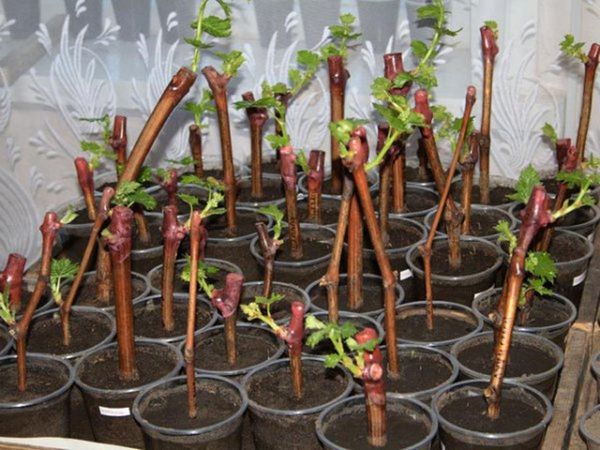

Unlike other plants, the snowberry is rarely propagated by cuttings.
Cuttings require a lot of moisture to root. In the first winter they need to be covered to avoid frostbite.
This method is more suitable for professional breeding and is able to create the largest number of seedlings.
Seeds
The seed method for breeding a snowberry is extremely rarely used. Its seeds are so small that this process is very time consuming and ineffective. The seeds are separated from the pulp, washed and dried.
Sowing seeds is carried out in the fall, after overwintering under the snow, the seeds are hardened and in the spring you can expect their germination.
It is best to sow them in boxes, and not in open ground, since there is a high probability that during snowmelt they will go deep into the ground and will not sprout... Watering is carried out carefully, and when the seeds germinate, tiny plants dive and planted on undergrowth in open ground.
"Children" need to be protected from the abundant sun and drafts with protective shields.
Shrubs with bright fruits
On cloudy autumn days, the beauty of the garden gradually dissolves and before us is no longer the beloved garden filled with bright colors and splashes of color, but a gray-brown joyless picture. Of course, you shouldn't forget about the blood-red bark grass - this is one of the main accents, but the fruits of the shrubs can also become a decoration of the garden in the autumn-winter period. Spots of color scattered over the site will not allow the glow of its former abundance to go out. Take note cotoneaster horizontal, snowberry and rose hip.
Horizontal cotoneaster


Horizontal cotoneaster
Horizontal cotoneaster is a slow-growing creeping shrub with horizontally growing branches up to 80 cm high with small dark green glossy rounded leaves. It blooms with pale pink flowers, and in the middle of summer, small fiery red fruits appear that can last until next spring. Autumn foliage takes on a bright crimson color, which adds to the decorative effect of the garden.
Take a closer look at the frost-resistant varieties Ursinow (USDA 4) up to 0.4 m high and Atropurpureus (USDA 4) up to 80 cm high.This shrub is not sheared, it is used in the garden to create retaining walls, rockeries and fortification of slopes, as well as a cover plant ...
Snowberry
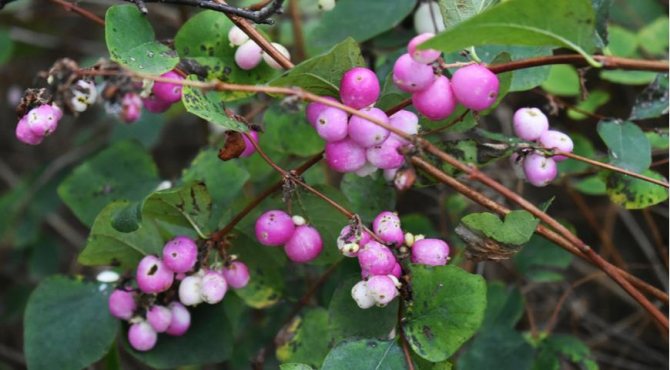

Snowberry
I'm more than sure if you ask what this shrub looks like in summer, almost no one will remember. Indeed, it is true, it is completely inconspicuous, does not stand out in any way against the background of the main green mass. However, with the onset of cold autumn days, when the foliage from most of the trees has already been dropped, it comes to the fore - a snowberry. Everyone knows him from childhood: there is probably not a single child who would not pick white berries and eat them with his hands or feet - it was child's play, although then no one knew the name - just a bush with white berries. Now imagine that the berries are pink, and they are perfectly visible from all corners of the garden, no matter how you turn away. For this truly beautiful outfit, the snowberry can and should be put in a row along with other ornamental shrubs.
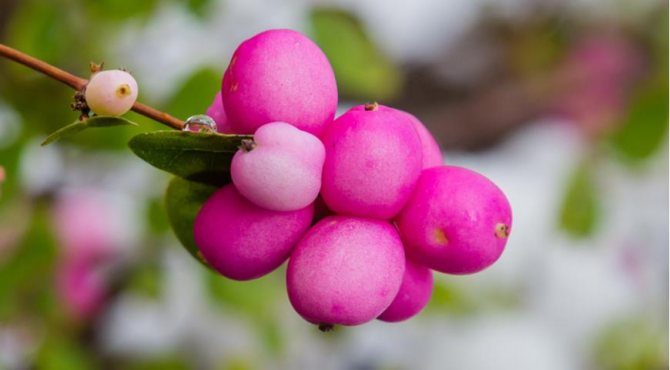

Snowberry
When buying a variety of snowberry, pay attention to winter hardiness, there are varieties with winter hardiness zones 5 and 6. Take a closer look at the Mother of Pearl (USDA 3) snowberry variety, up to 1.7 m high, up to 2 m in diameter, or Magic Barry (USDA 4), up to 2 meters high with a spherical openwork crown.
With proper and timely cutting, you can maintain the size of the bush at the desired level. In the garden it looks good in a mixborder, in woody compositions and as a low hedge.
What plants can be planted in the shade in the country
Often places remain empty on the site, where shadow or partial shade is created throughout the day. And many novice gardeners are puzzled what kind of plants can be planted in the shade in the country. But there is also an answer to this question. Below are shade-loving shrubs for the garden, which are also perennial, unpretentious:
- euonymus. Looks especially beautiful in autumn. It is impossible to pass by such a bush, as if blazing with fire;
- derain. This shrub is also suitable for shady places. You can plant it along the fences, from which the site will look even better;
- barberry. His description says that low-growing varieties can be planted under trees, and those that grow high enough will look good at home;
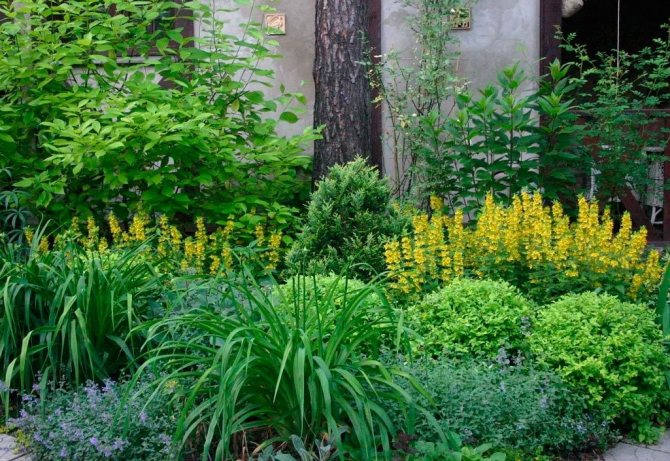

Shade-tolerant shrubs for the garden
- viburnum. Shade-tolerant shrubs are also unpretentious to care for. Looks very attractive in the autumn;
- snowberry. As you know, in the period when its berries begin to ripen, the shrub looks just amazing. In addition, it can be planted in the shade or partial shade;
- magonia.An evergreen plant is not only shade-tolerant, but also winter-hardy. In addition to this, the shrub survives drought well;
- elder. Unpretentious perennial shrubs can grow both in sunny areas and in a shaded place;
- haulteria. Slow growing shrub, but blooms beautifully. Will grow for 50 years.
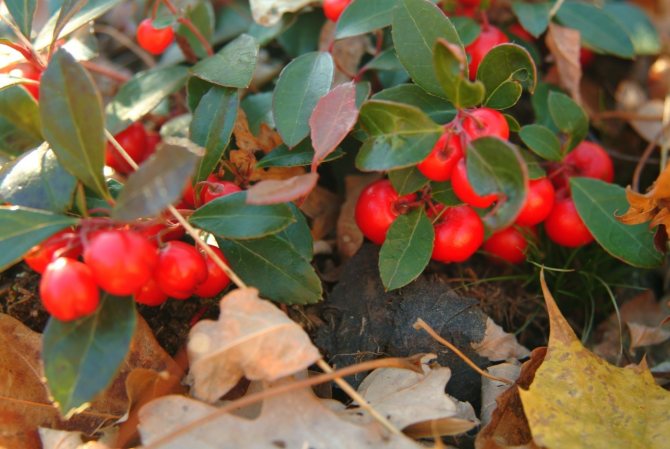

Haulteria
Shade-loving shrubs are an excellent solution for those who want to improve their area, which is partially or completely shaded. These plants not only allow you to decorate the site in spring, summer, but also in autumn.
The garden looks very nice, in which various types of bush plants are planted. From the onset of the flowering period until frost, the site will be buried in flowers. One shrub will bloom, it is the turn to please with the splendor of flowers of another ornamental plant. The main thing is to choose the right types and varieties and provide decent care.
Technology and timing of planting a snowberry
The most important advantage of a shrub when breeding is unpretentiousness. The plant is not demanding on the amount of shade or sunlight, dryness or moisture. In addition to landscape design, it can be used to prevent soil shedding. Thick roots can stop soil erosion. Planting can be done before winter or after it. The ground must be prepared in advance.
Preparation is as follows: a hole or trench is dug in advance. In the fall, they dig up a month before planting, and for spring work, you need to prepare in the fall. Lay a layer of crushed stone and a special soil saturated with useful components in the soil.
Depending on the requirements for the plant, planting is carried out using different technologies. For a hedge, seedlings older than a year are perfect. Before planting, you need to draw a straight line of the hedge, for this you can use twine. Along its entire length, you need to dig a trench, the width of which is 0.4m, and the depth is not more than 0.6m. 4-5 shrubs can be planted per 1m of length. For planting individual bushes in a flower bed, you need to adhere to the distance between them 1.2m-1.5m. The size of the hole for the bush is approximately 0.65x0.65m.

